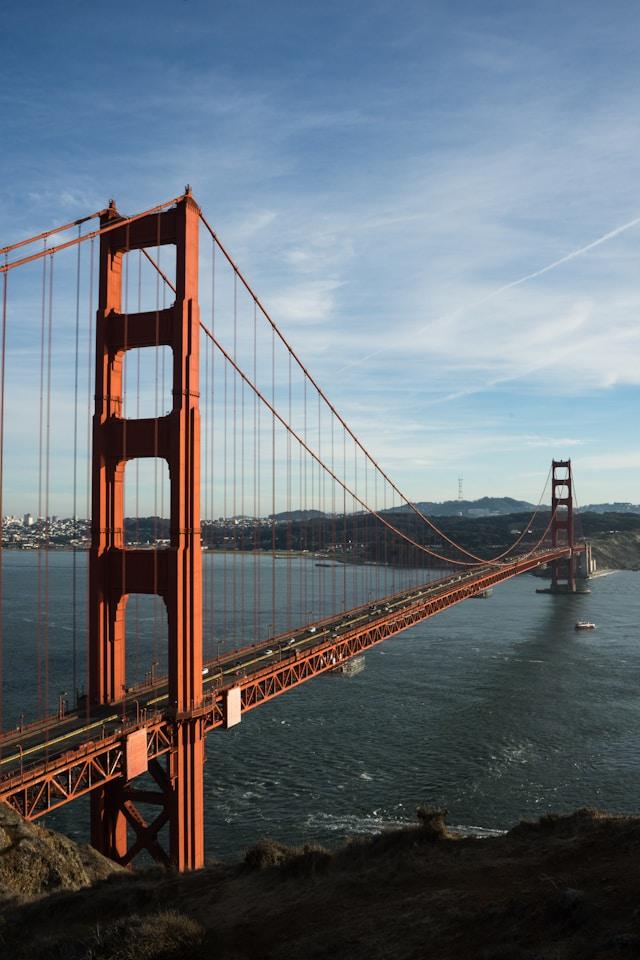Golden Gate Bridge
The Golden Gate uses the largest bridge cables ever made, long enough to encircle the world more than three times at the equator.
The Golden Gate Bridge's builders introduced many innovations, but perhaps the most impressive was the precise and efficient technique they used to construct the massive cables.
The bridge's designers carefully calculated the graceful dip of the suspension cables between the two towers to carry the needed weight. The cables had to be flexible enough to bend up to 27 feet laterally, in the Gate's formidable winds, and strong enough to support the structure of the bridge. The planned cables would be so long and strong that they would need to be fabricated in place.
The well-known engineering company of John Roebling and Sons oversaw the cable construction. Roebling had built many of the world's longest bridges -- including the Brooklyn Bridge, 52 years earlier. The firm had devised the most efficient strength-to-rigidity ratio for cables. It had also developed a technique of spinning cables on-site. The Roebling crew's work on the Golden Gate Bridge continued a tradition of innovation.
Cable spinning began in October 1935. To create the cables, Roebling developed a method called parallel wire construction. The innovative technique enabled a cable of any length and thickness to be formed by binding together thin wires. It promised to give engineers the freedom to build a bridge of infinite length.
Hundreds of wires, each roughly the diameter of a pencil, were bound together into strands. Hydraulic jacks then bundled and compressed 61 strands to make a cable. Each of the two main cables is just over three feet in diameter, 7,659 feet long and contains 27,572 parallel wires. The Golden Gate uses the largest bridge cables ever made -- long enough to encircle the world more than three times at the equator.
Source: Ultimate Facts
🖼️https://unsplash.com/photos/a-view-of-the-golden-gate-bridge-from-the-top-of-a-hill-81Rl3Wv5K6o?utm_content=creditShareLink&utm_medium=referral&utm_source=unsplash
By *Muhammad Dangiwa*
The Golden Gate uses the largest bridge cables ever made, long enough to encircle the world more than three times at the equator.
The Golden Gate Bridge's builders introduced many innovations, but perhaps the most impressive was the precise and efficient technique they used to construct the massive cables.
The bridge's designers carefully calculated the graceful dip of the suspension cables between the two towers to carry the needed weight. The cables had to be flexible enough to bend up to 27 feet laterally, in the Gate's formidable winds, and strong enough to support the structure of the bridge. The planned cables would be so long and strong that they would need to be fabricated in place.
The well-known engineering company of John Roebling and Sons oversaw the cable construction. Roebling had built many of the world's longest bridges -- including the Brooklyn Bridge, 52 years earlier. The firm had devised the most efficient strength-to-rigidity ratio for cables. It had also developed a technique of spinning cables on-site. The Roebling crew's work on the Golden Gate Bridge continued a tradition of innovation.
Cable spinning began in October 1935. To create the cables, Roebling developed a method called parallel wire construction. The innovative technique enabled a cable of any length and thickness to be formed by binding together thin wires. It promised to give engineers the freedom to build a bridge of infinite length.
Hundreds of wires, each roughly the diameter of a pencil, were bound together into strands. Hydraulic jacks then bundled and compressed 61 strands to make a cable. Each of the two main cables is just over three feet in diameter, 7,659 feet long and contains 27,572 parallel wires. The Golden Gate uses the largest bridge cables ever made -- long enough to encircle the world more than three times at the equator.
Source: Ultimate Facts
🖼️https://unsplash.com/photos/a-view-of-the-golden-gate-bridge-from-the-top-of-a-hill-81Rl3Wv5K6o?utm_content=creditShareLink&utm_medium=referral&utm_source=unsplash
By *Muhammad Dangiwa*
Golden Gate Bridge
The Golden Gate uses the largest bridge cables ever made, long enough to encircle the world more than three times at the equator.
The Golden Gate Bridge's builders introduced many innovations, but perhaps the most impressive was the precise and efficient technique they used to construct the massive cables.
The bridge's designers carefully calculated the graceful dip of the suspension cables between the two towers to carry the needed weight. The cables had to be flexible enough to bend up to 27 feet laterally, in the Gate's formidable winds, and strong enough to support the structure of the bridge. The planned cables would be so long and strong that they would need to be fabricated in place.
The well-known engineering company of John Roebling and Sons oversaw the cable construction. Roebling had built many of the world's longest bridges -- including the Brooklyn Bridge, 52 years earlier. The firm had devised the most efficient strength-to-rigidity ratio for cables. It had also developed a technique of spinning cables on-site. The Roebling crew's work on the Golden Gate Bridge continued a tradition of innovation.
Cable spinning began in October 1935. To create the cables, Roebling developed a method called parallel wire construction. The innovative technique enabled a cable of any length and thickness to be formed by binding together thin wires. It promised to give engineers the freedom to build a bridge of infinite length.
Hundreds of wires, each roughly the diameter of a pencil, were bound together into strands. Hydraulic jacks then bundled and compressed 61 strands to make a cable. Each of the two main cables is just over three feet in diameter, 7,659 feet long and contains 27,572 parallel wires. The Golden Gate uses the largest bridge cables ever made -- long enough to encircle the world more than three times at the equator.
Source: Ultimate Facts
🖼️https://unsplash.com/photos/a-view-of-the-golden-gate-bridge-from-the-top-of-a-hill-81Rl3Wv5K6o?utm_content=creditShareLink&utm_medium=referral&utm_source=unsplash
By *Muhammad Dangiwa*




